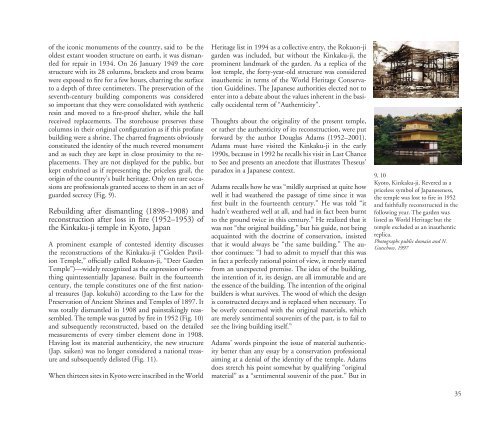KVPT’s Patan Darbar Earthquake Response Campaign - Work to Date - September 2016
You also want an ePaper? Increase the reach of your titles
YUMPU automatically turns print PDFs into web optimized ePapers that Google loves.
of the iconic monuments of the country, said <strong>to</strong> be the<br />
oldest extant wooden structure on earth, it was dismantled<br />
for repair in 1934. On 26 January 1949 the core<br />
structure with its 28 columns, brackets and cross beams<br />
were exposed <strong>to</strong> fire for a few hours, charring the surface<br />
<strong>to</strong> a depth of three centimeters. The preservation of the<br />
seventh-century building components was considered<br />
so important that they were consolidated with synthetic<br />
resin and moved <strong>to</strong> a fire-proof shelter, while the hall<br />
received replacements. The s<strong>to</strong>rehouse preserves these<br />
columns in their original configuration as if this profane<br />
building were a shrine. The charred fragments obviously<br />
constituted the identity of the much revered monument<br />
and as such they are kept in close proximity <strong>to</strong> the replacements.<br />
They are not displayed for the public, but<br />
kept enshrined as if representing the priceless grail, the<br />
origin of the country’s built heritage. Only on rare occasions<br />
are professionals granted access <strong>to</strong> them in an act of<br />
guarded secrecy (Fig. 9).<br />
Rebuilding after dismantling (1898–1908) and<br />
reconstruction after loss in fire (1952–1953) of<br />
the Kinkaku-ji temple in Kyo<strong>to</strong>, Japan<br />
A prominent example of contested identity discusses<br />
the reconstructions of the Kinkaku-ji (“Golden Pavilion<br />
Temple,” officially called Rokuon-ji, “Deer Garden<br />
Temple”)—widely recognized as the expression of something<br />
quintessentially Japanese. Built in the fourteenth<br />
century, the temple constitutes one of the first national<br />
treasures (Jap. kokuhō) according <strong>to</strong> the Law for the<br />
Preservation of Ancient Shrines and Temples of 1897. It<br />
was <strong>to</strong>tally dismantled in 1908 and painstakingly reassembled.<br />
The temple was gutted by fire in 1952 (Fig. 10)<br />
and subsequently reconstructed, based on the detailed<br />
measurements of every timber element done in 1908.<br />
Having lost its material authenticity, the new structure<br />
(Jap. saiken) was no longer considered a national treasure<br />
and subsequently delisted (Fig. 11).<br />
When thirteen sites in Kyo<strong>to</strong> were inscribed in the World<br />
Heritage list in 1994 as a collective entry, the Rokuon-ji<br />
garden was included, but without the Kinkaku-ji, the<br />
prominent landmark of the garden. As a replica of the<br />
lost temple, the forty-year-old structure was considered<br />
inauthentic in terms of the World Heritage Conservation<br />
Guidelines. The Japanese authorities elected not <strong>to</strong><br />
enter in<strong>to</strong> a debate about the values inherent in the basically<br />
occidental term of “Authenticity”.<br />
Thoughts about the originality of the present temple,<br />
or rather the authenticity of its reconstruction, were put<br />
forward by the author Douglas Adams (1952–2001).<br />
Adams must have visited the Kinkaku-ji in the early<br />
1990s, because in 1992 he recalls his visit in Last Chance<br />
<strong>to</strong> See and presents an anecdote that illustrates Theseus’<br />
paradox in a Japanese context.<br />
Adams recalls how he was “mildly surprised at quite how<br />
well it had weathered the passage of time since it was<br />
first built in the fourteenth century.” He was <strong>to</strong>ld “it<br />
hadn’t weathered well at all, and had in fact been burnt<br />
<strong>to</strong> the ground twice in this century.” He realized that it<br />
was not “the original building,” but his guide, not being<br />
acquainted with the doctrine of conservation, insisted<br />
that it would always be “the same building.” The author<br />
continues: “I had <strong>to</strong> admit <strong>to</strong> myself that this was<br />
in fact a perfectly rational point of view, it merely started<br />
from an unexpected premise. The idea of the building,<br />
the intention of it, its design, are all immutable and are<br />
the essence of the building. The intention of the original<br />
builders is what survives. The wood of which the design<br />
is constructed decays and is replaced when necessary. To<br />
be overly concerned with the original materials, which<br />
are merely sentimental souvenirs of the past, is <strong>to</strong> fail <strong>to</strong><br />
see the living building itself.”<br />
Adams’ words pinpoint the issue of material authenticity<br />
better than any essay by a conservation professional<br />
aiming at a denial of the identity of the temple. Adams<br />
does stretch his point somewhat by qualifying “original<br />
material” as a “sentimental souvenir of the past.” But in<br />
9, 10<br />
Kyo<strong>to</strong>, Kinkaku-ji. Revered as a<br />
priceless symbol of Japaneseness,<br />
the temple was lost <strong>to</strong> fire in 1952<br />
and faithfully reconstructed in the<br />
following year. The garden was<br />
listed as World Heritage but the<br />
temple excluded as an inauthentic<br />
replica.<br />
Pho<strong>to</strong>graphs public domain and N.<br />
Gutschow, 1997<br />
35




